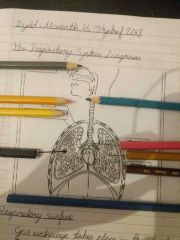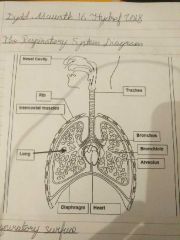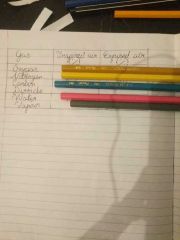![]()
![]()
![]()
Use LEFT and RIGHT arrow keys to navigate between flashcards;
Use UP and DOWN arrow keys to flip the card;
H to show hint;
A reads text to speech;
25 Cards in this Set
- Front
- Back
|
What does respiration mean? |
The release of energy in all living plant and animal cells. |
|
|
What does aerobic respiration mean? |
The release of energy (ATP) using oxygen |
|
|
What is anaerobic respiration? |
The release of a little bit of energy (ATP) without oxygen |
|
|
What is lactic acid? |
A poison which builds up in anaerobic respiration |
|
|
What is oxygen debt? |
This is the amount of oxygen needed to cancel out the lactic acid built up in anaerobic respiration |
|
|
What is the respiratory system? |
A system that aids sufficient gas exchange |
|
|
What are alveoli? |
Site of gas exchange |
|
|
What is inspiration? |
The taking in of air |
|
|
What is expiration? |
The breathing out of air |
|
|
What is mucus? |
A thick liquid which covers your air passages |
|
|
What is cilia? |
Small hairs on the inside of air passages |
|
|
What is emphysema? |
A disease caused by smoking which breaks down the walls of the alveoli |
|
|
What is the transfer diagram for aerobic respiration? |
Glucose + oxygen →carbon dioxide + water + ATP |
|
|
What is aerobic respiration? |
This is the usual type of respiration seen in humans - it uses oxygen. The reactions of respiration take place in tiny structures called mitochondria and they are referred to as the 'power-houses' of the cell because they give the cell ATP. These reactions are enzymes- controlled reactions which act as biological catalyst. |
|
|
What is ATP? |
Energy is released from aerobic respiration in the form of ATP. ATP transfers chemical ATP (energy), from the energy rich substances in the cell, to the cell's own reactions that require energy. When ATP breaks down, the ATP released is used by the cell for processes such as active transport, DNA replication and muscle contraction. |
|
|
What is the transfer diagram for anaerobic respiration? |
Glucose → lactic acid + ATP |
|
|
What is anaerobic respiration? |
Respiration can happen without oxygen. This process is called anaerobic respiration. Only a small portion of the chemical energy contained in glucose is released therefore lactic acid is produced. Lactic acid is poisonous to the body and can cause the muscles to stop working. |
|
|
Explain oxygen dept |
The lactic acid that has built up during anaerobic respiration need to be broken down. It gets broken down in the liver. The blood carries the lactic acid there. Oxygen is required in the breakdown of lactic acid. Heavy breathing after exercising provides the extra oxygen requires to break down lactic acid, and is known as the oxygen debt. This is followed by panting to allow aerobic respiration to resume. |
|
|
Explain anaerobic respiration efficiency |
This type of respiration is less effecticient due to the incomplete breakdown of glucose. This results in less ATP produces per glucose molecule and so less energy is released. |
|
|
Idk just expand on the respiratory system |
Larger organisms have a higher oxygen demand that smaller organisms due to their larger volume. Therefore there is a news for a complex ventilation system that can quickly supply enough oxygen and remove the waste carbon dioxide produced, a concentration gradient needs to be maintained. |
|

Label the respiratory system |

|
|
|
Respiratory surface - explain the function of alveoli and it's adaptation. |
Gas exchange takes place in the alveoli. Every alveoli is adapted for sufficient gas exchange. 1. They have a very good blood supply - maintaining concentration gradient. 2. They have a large surface area. 3. They have walls that are one cell thick - short diffusion pathways for gases. 4. They have a moist lining. |
|

Fill in this table |

|
|
|
What is mucus and cilia? |
The mucus and the cilia are the 'protective cleaners' for the respiratory system. The bacteria and dust particles stick to the mucus and the cilia then moves the mucus to the Mitochondria provide the energy for the movement of the cilia |
|
|
What are the affects of smoking? |
- Chemicals in smoke paralyse cilia and clog up the mucus. - Smoking causes this cleansing system to fail and this causes excessive coughing. - As their functions are now prevented there is a risk of disease in the respiratory system. - tar coats the lining of the alveoli, making them less able to take in oxygen. It also contains carcinogens which cause lung cancer. - Emphysema is a smoking related disease that caused the walls of the alveoli to break down reducing the surface area and r silting in less gas exchange. - It is hard to quite smoking as cigarettes contain an additive drug called nicotine. |

